2009 Climbers
partial list with Blogs
- Alec Turner
- Adrian Ballinger
- Bill Burke
- Billi Bierling
- Bruce Parker
- Bud Allen
- Chris Dovell
- Christophe Vandaele
- David Tait
- Eugene Constant
- Gilad Stern
- Ian Rogers
- Johnny & Brain Strange
- John Golden
- Lance Fox
- Mike Farris
- Michael Morales
- Nic Cunningham
- Megan Delehanty
- Robby Kojetin
- Scott Parazynski
- Tomsky Arnold
- Valerio Massimo
- Wendy Booker
- Yuri Pritzker
South Col
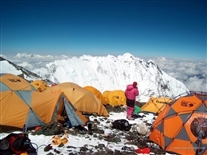
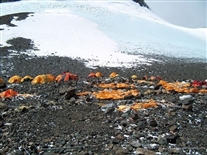
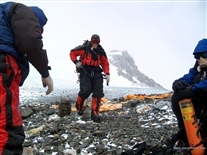
Lhotse Face
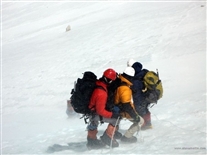
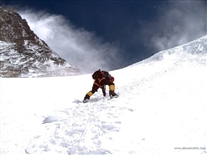
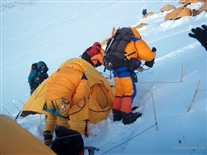
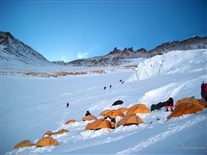
Western Cwm & C1
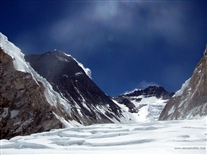
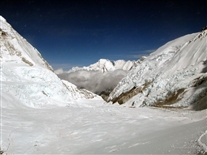
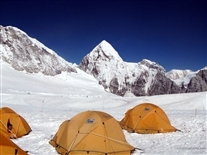
Khumbu Icefall
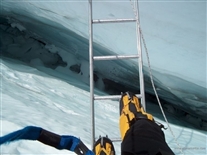
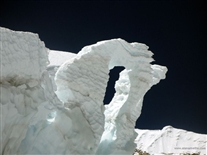
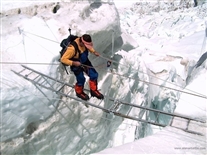
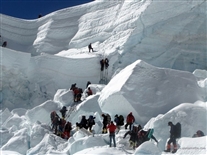
Everest Base Camp
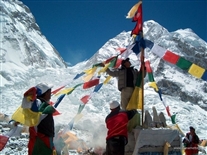
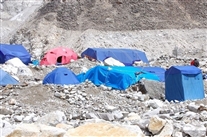
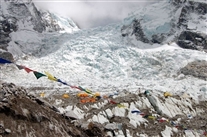
Trekking to Base Camp
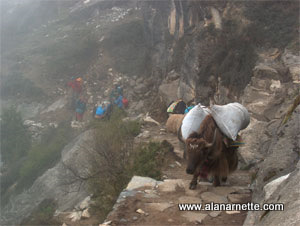
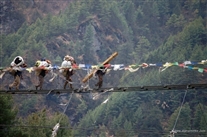
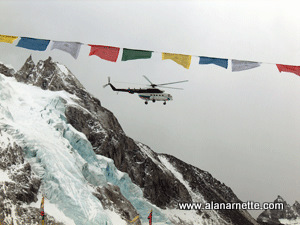 |
Updated May 31, 2004 - Final -2005 to come!!!
It's over. 2004 Spring Everest is in the history books. The Sherpas who tended the ice fall are back in their villages, the porters are working for trekkers, not climbers on Everest, and the Khumbu has a quiet feeling as the monsoon season begins. And it has been another season for the record books.
Over 150 climbers reached the summit on all routes, 99 on May 16 and 17 alone!. Using a summit (not attempts) ratio of clients: guides: sherpas of 5:2:8 this would imply that 50 summiteers were clients, 20 guides and 80 Sherpas. By far, Sherpas have summited Everest more than any other category of climber. The most sought out Sherpas have summited 5 or more times and know the routes, conditions and how to deal with Westerners. I would estimate that 80% of Sherpas and Guides have summited before so that would imply that there were 70 new summits this season.
The most impressive climb was, without question, the Russians who climbed a new route on the North Face. Then there was the Chilean team who were the first summit with Brit, Annabelle Bond. While I did not cover this expedition in detail, looking at Annabelle's website, it is clear that sex-appeal has made it's way to Everest way beyond "making sauce".
There was another speed record this season. Pemba Dorji Sherpa, 26, made his way from base camp to the summit in a record 8 hours and 10 minutes. Pemba;s calim was not suported with any evidence and his record was taken away by the Nepal Supreme Court in 2017.
This is real in that he takes every step without aid. He does have support at every camp to provide him with food and water thus preventing him from carrying the normal loads. In 2003, I was passed on his way down by Sherpa, Lakpa Gheylu who did the trip in 10 hours and 46 minutes. He was almost running while carrying a small pennant. He was clearly excited and had plenty of energy to spare. While this may seem like a folly, it translates into steady work for these Sherpas and thus a better life for their families.
The commercial expeditions who host most of the non-professional climbers were well represented. Alpine Accents, Himalayan Experience, Adventure Consultants and others all put clients on the summit. Then there were the single or small teams like RAF Atkins and the Mexico/Canada expedition. Without the leverage of 7 or more teammates, they made their way up the Hill and stood on top of the World! Well done, well done.
As for my best moment of 2004, it is a tie between Adventure Consultants patience, Dave D'Angelo's videos and the Mexico/Canada no O's attempt. AC sat at the South Col for three nights waiting for the weather to clear. Past expeditions have been rushed, but this team showed incredible, more than would be expected, patience. They used valuable oxygen waiting out the weather and then ... they summited. A great performance! Dave demonstrated incredible technology (and personal focus) with his fantastic video on his North Side summit. The Mexico/Canada started off strong being the first team to C3. The had some of the most revealing dispatches and ended up with some on the summit, some in trouble and some helping those in trouble. This was Everest at it's best and hardest.
The season was not without tragedy and controversy. At least seven climbers died this year, more than in the past several years. Ropes were removed on the North side while climbers still needed them. Oxygen bottles were thrown down the North Face endangering the Russian climbers. And the search for Mallory and Irvine's camera turned up short, as far as we know. Death, politics and dreams unfilled. This is what Everest is all about.
But the Russian accomplishment cannot be topped. I am stunned by their strength, courage and teamwork. This is one for the history books.
So that is it for 2004. I have thoroughly enjoyed covering Everest from my Colorado home. If you have any comments or suggestions, please contact me. I plan on covering Everest 2005 so I hope to see you in about 10 months!
Updated May 30, 2004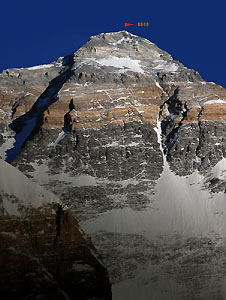
The Russians have made it!!. Clearly the most significant event of this Spring climbing season on any mountain, this incredible team established the first new route in 20 years on Everest. They climbed the wall on the North Face - direct. Lot's has been written so I thought I would try to find out, in those immortal words of Butch in Butch Cassidy and the Sundance Kid: "Who are those guys?"
Their web site has a short bio on each climber plus a great interview with, Jury Ermachek, prior to the climb. It fairly well tracked what happened. Reading the climbing resumes of the team members, I was struck by the difficulty and remoteness of their climbs. No "standard" routes for them! While even the normal routes are dangerous and difficult on 8,000m mountains, these guys have the required experience to take on the North Face in the style they did.
Updated May 29, 2004
The final story for Everest 2004 remains the Russians on the North side. They are doing, arguably, the most difficult route on Everest - the central North Face. According to a satphone call into ExplorersWeb they are at 8600 meters and experiencing hard rock that their pitons cannot penetrate. A small group spent the night with no tents, just their down suits.
For many people, this expedition is the poster child for climbing. Big men in down suits with heavy boots taking a step and pounding a sharp spike (piton) into a rock wall. They attach a oval shaped metal ring (carabiner) to the piton and then put drive their spiked boots (crampons) a little higher protected only by a thin nylon rope attached to the pitons. Step by step, they make progress. Hopefully they will summit today or tomorrow.
I have enjoyed many of the dispatches this year but there were some great pictures as well. And now that most expeditions have returned to the land of fast Internet connections, there are some very nice ones posted. The Mexico/Canada site has some of the best Hillary Step pictures. You can see how little snow there is this year on the step. The Irish Expedition has some nice summit shots. The Algonquin College expedition have a sprawling variety of expedition shots in a creative format.
My top vote for 2004 goes to ExplorersWeb (Mt. Everest.net) and Dave D'Angelo's multiple videos from his North Side summit climb. It is a remarkable series of sharply edited footage matched with head bobbing rap music that results in a fast paced approach. These are not your normal climbing videos. Well done Dave!
Updated May 27, 2004
The big news is that the last of the South Side expeditions, Adventure Consultants, have put three clients on the summit along with one guide and five Sherpas. The first group summited about 10:15 in the morning after spending a few days waiting out high winds on the South Col. This was true determination matched with incredible planning and experience. Since most permits on the Nepal side demand you are off the mountain by June 1, the AC team was working against weather, politics and the harsh conditions above 8,000 meters. My hat is off to Guy and his team for taking a different approach that, in my opinion, resulted in one of the best successes in years. Good on ya' AC!!
Samantha O'Carroll, part of the firtst summit group with AC, is now the sixth Irish woman to summit. Another notable result was from Anthony Baldry who now has the seven summits under his belt. I was on a climb with Anthony last year.
On the North, the Russians are playing a slightly different game since their permit has different conditions but they must obey the same weather gods. Thus they are not going for it today but will soon.
Meanwhile, our friends over at Mt. Everest.net are celebrating one of their own, Dave D'Angelo's summit. Dave made it to the top in good style. He reports that he carried a video camera but didn't use it given his cold hands. Hey, it's OK Dave you gave us all some of the best real-time video in years. Now just get off the hill and come home safe.
A final dispatch from RAF Atkins (one of my favorites this year this this was his third attempt and he made it!) describes his battle coming down from the summit as he ran out of oxygen. Ted writes with complete honesty and illustrates how dangerous climbing without oxygen can be - especially when you don't plan for it
Updated May 26, 2004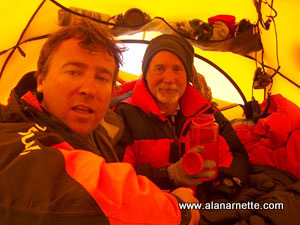
Well, best laid plans on both sides of the Mountain have been halted by high winds. The Russians are ready for their final push on the wall to the summit and Adventure Consultants is hunkering down at the South Col for another day. While, there situation is not rare it is not desirable since living at 8,000m is temporary at best.
In 2003, we spent two nights at C4 before our summit attempt. At that altitude, you do not want to eat. You simply do not have an appetite. Putting something as simple as a Pop Tart in your mouth sometimes creates an involuntary gag response. Oatmeal and Cup-o-Soup are popular items. The Sherpas are continiously melting ice and shot drinks. Staying hydrated is the number one priority.
And then there is sleeping. First, there are four people in a three person tent so it is very cramped. With no room to move when you lay down, claustrophobia is a common feeling. Usually, the climbers are using bottled oxygen in very low flow rates - 1 liter an hour. Thus helps with the altitude but only compensates a few thousand feet so it feels like 23,000'. Finally, any sleep is short with frequent interruptions from tentmates moving, winds pounding the tent or simply being too tired to sleep.
All in all, not the ideal set up for an 18 hour climb of your life! But these are experienced expeditions and will ensure all the climbers are ready to go when the time comes. And sometimes, this will mean going down not up.
Updated May 25, 2004
Another excellent weekend for Everest summitters on both sides. First, on the north, Russell Brice's HimEx expedition put 30 climbers on the summit. They went in two teams and the total spilt was 13 clients, 12 Sherpas and 4 guides. Of significance was Russell's decision to redirect 3 of his Sherpas to assist climbers in difficulty. This is a true mark of leadership for any expedition but for Russell this has almost become a standard event year in year out. He seems to "take care" of all the climbers on his North Side.
While I am positive he does not plan for this, he does not hesitate to give assistance regardless of the reason for the trouble. It is interesting to note that the major commercial expedition companies such as Himalayan Experience, Adventure Consultants, International Mountain Guides, Alpine Ascents International and others have a semi-formal agreement to give aid to one another at any time. This is yet another reason to go with a professional guide if you choose to use a guide service.
Unfortunationally for Adventure peaks, they aborted their summit bid and Kevin Donovan gave up his attempt. They report doing this to assist climbers in need as well. Oath 7 climber Dan Lochner has a sobering report of his north side summit, a must read.
On the South, AAI put 7 clients, 8 Sherpas, and 3 guides on the top. One comment I found interesting was "...It's now midnight, and Lama Geshe seems to be right in saying this is an auspicious day to climb." The Lamas normally select one or two "auspicious" days each season. This is a day that was blessed and favorable for a summit. Vern Tejas had mentioned many times that this was a strong team and their times proved that out with a summit at 9:00 AM and back in C4 by 1:30 PM.
The last large team is Adventure Consultants and as of the last night, their web site reports them at C4. With all their preparation this year (going down valley, a few extra nights at C2) I am optimistic that they will have a great summit, weather permitting.
With all the activity settling down, I will do a recap and some final comments around the speed record this week and then, 2004 is over.
Updated May 21, 2004
Some disturbing news of death on Everest the past two days. Ben of Algonquin College expedition reports about the news on the South. Also there are reports of deaths on the North. These reports are always handled carefully since misinformation is very, very common about trouble on Everest. It seems that rumors spread quickly and with all the languages and cultures, accurate data is difficult to determine. Also, when there is a death, there is a huge sensitivity to family and not wanting to preempt proper notification.
Most of the South Side summiters are not sending dispatches since after a summit or an attempt all they want to do is sleep, eat and speak with their families. But there are some good ones out there. Ed Viesturs reports about losing his appetite at altitude. And the Irish team reports on their trip back to BC.
The weather has been tough the last few days even causing the strong Russians to hunker down. But it looks like a window is emerging this weekend and we can expect several attempts on both sides. Of course on the South are AAI and AC, the last two major teams of the season, waiting at Camp 2. They continue to take their time and be careful with new snow fall. On the North in HimEx's huge team and some smaller ones like AdventurePeaks.
Back to the deaths for a moment. Climbing these big mountains is an upfront decision, obviously. Most climbers have carefully considered the risks and accepted the gamble. In modern times, Everest is a relatively safe mountain as long as climbers are in good fitness, use oxygen and go with competent Sherpas. But even with these precautions, impossible situations arise and climbers get into trouble. Usually, there are two reactions to these tragedies. First, the one of people not familiar with climbing who ask why someone would put themselves into such dangerous situations just to stand on top of a mountain. Then there are those who have a clear understanding of living life to the fullest and accepting the risks that come along.
Either viewpoint does not help the families left behind. Hopefully they can understand that their loved ones died living life as they saw it. Every person I have ever met on Everest and other mountains did not want to die. They did not want to leave their families behind. All they wanted to do is to try to climb a hard mountain, do their best and come home. Sadly, this is not always the case.
Updated May 19
Dr. Clare has become the first Irish to summit Everest and by all accounts she did it in style. According to their reports they left Camp 4 late the previous night and made the summit at 6:45 AM. To put this in context Ed Viesteurs reported almost an identical time for their summit climb. Most climbers leave about 10:00 PM and arrive about 9:00 AM. Anyway, Congrats to Dr. Dr Clare O’Leary on becoming the fir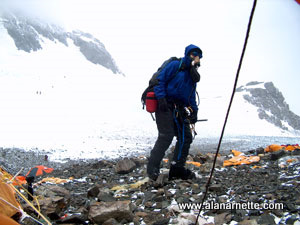 st Irish woman to reach the summit of Mount Everest. st Irish woman to reach the summit of Mount Everest.
On another note, Tom Masterson of the Mexico/Canada team is back at base camp. He had some trouble just below the South Summit and needed Dex and the assistance of his team mates to get down safely. Reports are that he is depressed about this turn of events. This is understandable for someone who attempted the highest peak on Earth, without supplemental oxygen and at age 59, I might add. To get as far as he did is simply amazing. he must be in spectacular shape - physically and mentally. So while he will feel down for a while, one day he will acknowledge that he achieved something that many people on think about given his age. I hear from a lot of prospective climbers through my site that ask if they are too old to start alpine mountaineering at age 35 or 40. Well, let me tell you about Tom!
While the summit gets all the attention, it is often the climb back to the South Col that is the most dangerous part. It doesn't matter if you made it to the top or not, you have been climbing for 12 to 15 hours and are out of gas. Legs feel like putty and your mind is either dealing with the disappointment of not summitting, the satisfaction of making it or the sense of doing your best. You are tired, very tired and dehydrated and hungry but most all you just want to sleep. This is the most dangerous time on Everest.
Some action still remains with AAI and AC both moving up hill today. Perhaps they will summit later his week. It seems like this has been another banner year for Everest summiters on the South Side!! And of course, there is the North. Those Russians keep plugging away and have broken 8,000 meters. They will probably do a summit bid in a few days after some rest at BC. And Russell Brice's 35 member HimEx team is still making their way towards a summit. So, hang in there, the action will not be over for another 10 days.
Updated May 17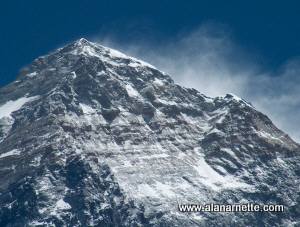
Wow, what a weekend! Over 80 climbers stood on top of the world. And early reports show no deaths. As for frostbite and other injuries, time will tell. It is very common for climbers to discover they are suffering from frostbite once they return to BC. Let's hope not this time. While it was a very successful 1st window, the action is not over with several expeditions moving up mountain for the next window. The best part of these later expeditions is that all the ropes are in and, unless there is a horridness storm, the tracks and steps will be well established. This isn't to say it is any easier, just a little more convenient. Each climber still must take the climb one step at a time.
The big news for this round of summits was the lateness of the actual summit. They were delayed by waiting for the Sherpas to fix the ropes to the summit. It is absolutely incredible what the Sherpas do. They carried oxygen bottles, tents and food to the South Col and then they lead all the climbers up the final push stopping to establish rope anchors every few hundred feet.
Now for some acknowledgments of some climbers I have been following. First, RAF Ted Atkins. He summited early morning May 16. I am very happy for him given this was his third attempt!
On the Mexico/Canada team, some tense moments. It seems that some of the climbers decided to use bottled oxygen upon leaving from Camp 4 after climbing almost the entire mountain without it. For whatever reason, some felt safer with it once they reached the South Col. This is understandable in that above 8,000 meters Everest becomes a very different mountain. Martin Boileau, who wrote some excellent dispatches, was the first of the team to summit. Well done Martin! And one climber who was near the summit without supplemental oxygen got into trouble. He was given dexametasone, a serious steroid only reserved for the most critical situations. Héctor and Andres, two of his teammates gave up their climb to help their friend down. This is what teams are all about. It is not the single individual but the team that bonds in the common goal to reach the summit or give it their best shot. While I am sure Héctor and Andres are disappointed, they will live the rest of their lives knowing they helped save a life.
Ed Viesturs and some of his team returned to Camp 2 not wanting to participate in a summit attempt with all the crowds. probably a smart move. It is common to have 30 to 40 climbers standing still for an hour at 28,000' in strong cold winds waiting for a slow group to make the Hillary Step or for ropes to be fixed. If climbers can avoid this, it is a wise decision.
Updated May 15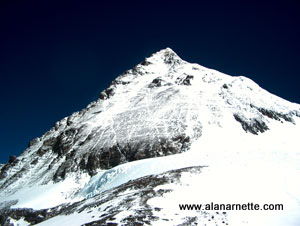
Reports are coming in that there are 40 climbers at the South Col and maybe up to 80 are heading to the roof. It seems that once a couple of teams identified the weather window for this weekend, the summit rush began. It is now clear why the Viesturs team made the summit push decision after going to Camp 2 to "check out the weather"! Adventure Consultants and AAI are still down valley so there will be another round of summit attempts later this month.
Both my summit attempts were in crowds such as this. It is a totally surreal environment. First, there is the South Col. Which is about the size of a football stadium covered with smallish size boulders. It is actually the saddle between Everest and Lhotse. And you are looking down on the summits of hundreds of snow covered mountain tops. This the place where airplanes fly.
Second is the Everest summit pyramid . Everest looks big from Kala Patar but camped only 200 feet from the pyramid base it looks daunting. You cannot see the true summit from Camp 4 or the South Col, you can only see the the South Summit. The route goes due North and starts fairly easy but quickly becomes steep on the way to the balcony.
Most everyone tries to get started no later than 10:00 PM. It is an 18 hour day and a lot of the climbing is in the dark. Most summits occur between 8:00 and 11:00 the next morning. Every climber has their headlamp on so when you look around all you see are dark figures and flickering lights. The Sherpas are focused on assisting climbers with their oxygen bottles. Everyone asks where your ice ax is and grabs your harness very hard - to make sure it is double backed for safety. This ritual is not reserved for guided clients but is for every climber, every Sherpa, every guide. This is not the time to make a mistake because you wanted to be polite.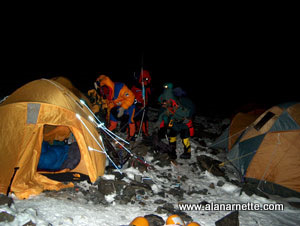
And then, usually in spurts of three to five climbers, they disappear into the darkness.
Those left behind watch them fade into the darkness and soon a congo line of lights starts snaking it's way higher and higher. If the weather is good, the stars are indescribable. There are so many, they can easily be mistaken for clouds. They breath the oxygen deeply and it feels cool in their lungs. The cold outside air touches only the small portion of their cheekbones that are left uncovered by the down suit. Most climbers have their goggles on to keep their eyes warm and switch to sunglasses at sunrise.
Step by step, the climbers start the journey higher. While focusing on the physical, it is the mental that dominates the moment. More on that later. But for now you Everest climbers: go high, go hard, climb safe and come home.
Updated May 13
Another excellent dispatch by Martin Boileau of the Mexico/Canada expedition. Many people think Everest climbers are burly, Testosterone driven men and women who are just crazy. Reading the dispatches from the Mexico/Canada team, Oath 7 and the Irish Expeditions reveals the deep thinking and careful approach it takes to attempt the highest peak on earth. Well done guys, regardless of the summit.
Surprise! Adventure Consultant is going down valley for a few days rest in the "heavy" air. I think this is an outstanding decision and the entire team will be much healthier for their summit bid. Also, the upcoming weather window for a summit is too short for their return. Enjoy the beds and O's!
Mountain Madness and Ed Visteurs are driving towards the summit of May 15 along with the Mexico/Canada and RAF Atkins. I wonder if Ed's team is trying to capture some footage of untracked snow?
The South gets a lot of press coverage but that may change given new technology. David D'Angelo of ExplorerWeb and Team ExWeb has posted a great series of dispatches on their site but also a very impressive video, complete with soundtrack! I am not sure if it the video is more impressive or the fact that it was produced on the mountain by Dave himeself, according to the kind folks over at Mt. Everest.net., but it is a great piece of work that should not be missed.
Updated May 12
A forecast showing summit winds of "only" 28 m.p.h. on May 16 so the Mexico/Canada team has left BC for a four day summit bid. The Viesturs/Gustafsson team has returned to Camp 2 to check out what was really happening with the weather since they had been getting different reports. They will go on to C4 weather permitting. They are on Everest making a film about the 1996 disaster so I am sure they want footage of good and bad weather.
Getting weather reports for any mountain range is difficult and often unpredictable. But Everest is in a league of her own. Jutting into the jet stream, she creates her own low pressure system that forces moisture out of the clouds and thus "weather. But wind is clearly the issue year in year out. 2004 seems to be especially bad. On the South Side, the final push to the summit is across a narrow ridge that drops thousands of feet on both sides. Even with fixed ropes, climbers have been blown off the ridge. Not a place to take a chance. So most teams wait until a calm window is forecasted before making their bid. Climbers can spend a week or two in BC waiting for a window.
Keeping your computers running seems to be RAF Ted Atkins biggest problem. He is making his third attempt, this time solo. According to his support team in the UK "...He is expected to reach the summit sometime on Thursday if all goes well, having set off from Camp 4 at about 9pm local on Wednesday night." That would put him on the same schedule as a couple of other teams.
Summit season has begun!
updated May 11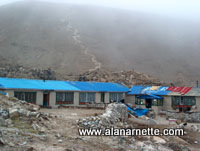
The dispatches from the South side are rolling in given that some expeditions who have spent their acclimatization night at Camp 3 are returning to base camp or even going down the Khumba valley to villages like Dingboche to rest for their summit bid . The choice to spend a few nights in a teahouse versus staying in BC is a matter of leader choice and controversy. The issue is the risk of picking up a cold or an infection from other climbers or trekkers due to the close quarters in the teahouses.
A couple of standout dispatches since the climbers have some time and higher speed connections. A must read report is from from Andrés Delgado on the Mexico/Canada expedition about one man's struggle with weather, illness and the call of family with the call of the mountain. A great read!! Another good report is from Oath7 with nice pictures and route description from the North Side
It sounds like the weather has been horrible this year - primarily the winds up high. As I have previously reported, many expeditions had their climbs stalled on both sides of Everest by the hurricane strength winds. Several climbers have expressed concerns about difficult climbing conditions on summit night since the winds will have blown the snow away.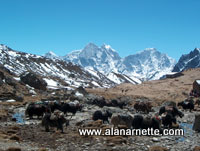
Irish update
Dr Clare O Leary Irish Expedition- South: Clare has made her round trip to C3 and is resting in Dingboche. Their latest dispatch makes for some nice reading about life behind the scenes. But when I read a heading about "Hurling", I thought Clare had gotten sick! Well it was really about the game of hurling which involves a long sticks and balls called sliothars. Based on games of the ancient Gaelic world, it is all the rage in Ireland these days. There is a great photo of one of their Sherpas with a hurley in his pack. I am sure I got something wrong here and will probably get an email from my Irish mentor "Scott Walker"
Samatha "Sam" O Carroll Adventure Consultants - South: Sam and the AC team is at C2 after a successful night at C3. AC usually does not like to leave BC so she will likely settle into the wait and see game over the next week waiting for a four day weather window before her summit bid.
Kate Rossiter-O'Flynn Mallory/Irvine -North: Her team is taking a slow and cautious pace up the North side. It is not clear how high she climbed thus far.
On the North Side, the Russians just keep on going. Their latest dispatch says "... 4 pitches made before and today we managed to fix five ropes more. In a result the expedition have reached 7800 meters. We have got 4-5 pitches left up to the beginning of the rocky bastion. Tomorrow the guys plan to engage in fixing these ropes, and then will descend to have a rest." Real climbing by some tough guys!
In the face of high winds, 80+km/h on the mountain, the HimEx team made the tactical decision to return to base camp. They still need to spend one night at Camp 2, 7500 meters, before their summit bid. No reason to worry since most summits happen in late May. So three weeks to go.
updated May 10
It seems that most South Side expeditions have spent the required night at Camp 3. C3 sits on the Lhotse face at 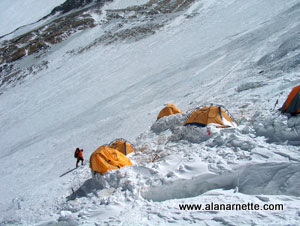 23,500'. Usually Sherpas have already made the climb to set up mostly yellow North face tents as well as fixing the ropes between the tents and C2. Adventure Consultants is spending Mother's Day in those tents. Climbing the Lhotse Face is the next big challenge after the Khumbu Ice Fall on the way to the summit. There are many ropes attached to the face with ice screws and anchors. Each rope is about 200' long so climbers must unclip their carabiners and jumars at each junction. This is a two step process so that the climber is always attached to the fixed line by at least one device. It is very normal for a long line of climbers to be going up and another long line coming down - usually Sherpas returning from carrying loads to the higher camps. So, in the middle of the Himalaya, you have a traffic jam! 23,500'. Usually Sherpas have already made the climb to set up mostly yellow North face tents as well as fixing the ropes between the tents and C2. Adventure Consultants is spending Mother's Day in those tents. Climbing the Lhotse Face is the next big challenge after the Khumbu Ice Fall on the way to the summit. There are many ropes attached to the face with ice screws and anchors. Each rope is about 200' long so climbers must unclip their carabiners and jumars at each junction. This is a two step process so that the climber is always attached to the fixed line by at least one device. It is very normal for a long line of climbers to be going up and another long line coming down - usually Sherpas returning from carrying loads to the higher camps. So, in the middle of the Himalaya, you have a traffic jam!
Depending on the weather, the Face is usually rock hard blue ice. You have to kick your crampon points into the ice stealing precious strength with each step. After a a few weeks, the path is fairly well set due to the thousands of kicks into the ice but one storm can have you starting all over again. To see a short video of the face click on the picture of C3 to the right.
Adventure Consultants report that their Sherpas have carried oxygen bottles to C4 on the South Col. The round trip from C2 took only 6-7 hours. To put this in perspective, most Western climbers take 5 hours to climb from C2 to C3 and another 4 to 5 from C3 to C4 for a total of 10 hours one way!!
updated May 7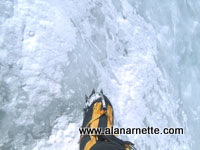
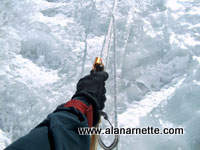 AAI is at C3 and report frozen rope in the morning and 100 degrees once the sun rose!! This is normal for the Western Cwm and the Lhotse Face since it is a 'U' shaped valley with nothing but white snow and ice all above 20,000' The sun reflects off every surface like aluminum foil around the face of a deranged tanner. Climbing is a strip show in progress. Starting with all surfaces covered, you take off the down layer first, then the wind layer, if possible, but keep a light layer on your hands and your head covered. The worry about frostbite shifts to sunburn. Both can end a climb at these altitudes! AAI is at C3 and report frozen rope in the morning and 100 degrees once the sun rose!! This is normal for the Western Cwm and the Lhotse Face since it is a 'U' shaped valley with nothing but white snow and ice all above 20,000' The sun reflects off every surface like aluminum foil around the face of a deranged tanner. Climbing is a strip show in progress. Starting with all surfaces covered, you take off the down layer first, then the wind layer, if possible, but keep a light layer on your hands and your head covered. The worry about frostbite shifts to sunburn. Both can end a climb at these altitudes!
The Irish expedition has made a bold prediction of a May 20 summit. Actually it is based on the weather forecast and they clearly acknowledge the margin of error. They have made it to Camp 3 on the South Side for an acclimatization night at 23,600' putting Dr. Clair ahead of Sam given that the Adventure Consultants team left base camp today on their way to Camp 3. AAI is on the same schedule. But getting to C3 is not any real indication of summit potential... it is Mother Nature!
José Luis Abreu of the Mexico/Canada team reports that one member,Andrés, got on top of the Geneva Spur and Alejandro and Luis reached the Yellow Band at 7600 meters. The rest of the team turned back before reaching Camp 3 and returned to Camp 2. They are climbing without O's. This is not so much of an problem below C3 but most climbers use O's above C3. I hope it was the high winds that kept the other climbers from going above C3.
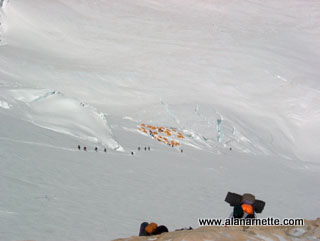
My experience has been that getting to C3, while hard, is where the real climbing of Everest begins. C3 is at 23,600'. The climb to the South Col, 8000m, is long, typically hot and exposes problems. It was on this climb, both times that I began to have doubts. I took the picture on the right of C3 from the Yellow Band. The yellow band itself is soft, crumbly limestone and is an extreme contrast from the ice or snow. There are two short (5 meter) sections that are a little steep. Again, not too difficult but the altitude really starts to take a toll in this part. Since this may be the first time some climbers have used bottled O's, the added discomfort of the mask, heavy bottle, gear, rock and some "real" climbing - this is the crux of the Geneva Ridge.
On the North, it seems that everyone has retreated to BC due to the high winds. However the Sherpas have established their C3 at 7900m. So teams on both sides at making great progress. It is very typical for one team to be ahead of the masses. More on this dynamic later. It makes for interesting politics on summit night!
The dispatches have been spotty thus far with AC, AAI, Visters and, my new favorite, the Irish team providing the most consistent dispatches. But most of all to every team: Climb safe, Climb on.
May 1-5 (updated May 5)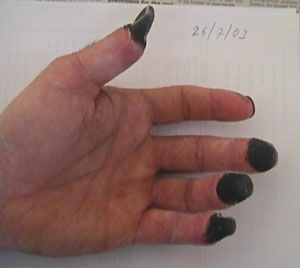
In spite of the high winds, several expeditions are planning on moving to C2 and C3 based on a forecast of a window. There is a two day window of reduced, but not insignificant winds, with temps still very cold thus making the risk of frostbite even greater. The large commercial teams are staying put but others are on the move:
Andrés Delgado of the Mexican-Canadian expedition. reports "The difficult days have arrived, days during which a strong psyche is much more useful than a pair of strong legs…." I like this comment in that after a month on Everest, it becomes mental, not physical. Maintaining focus on why you are there is hard, very hard. You can think of a million reasons to simply quit. But is is a tough team.
They are on their way to 8000 m, the death zone, to complete their acclimatization schedule. Remember this team is climbing without supplemental oxygen so they need to make some extra trips up the hill to generate more red blood cells (the cells that carry oxygen). While this is absolutely necessary, it adds risk to the summit attempt as compared to climbers using bottled oxygen. This may be the first team to summit in 2004!
In 2003, a friend of my climbing mate helped rescue a fallen climber. He helped save a life but he paid a huge price - he lost nine finger tips. The photo shows his left hand two months after the event. He was unselfish in his efforts without knowing the long term damage. I can only admire his sacrifice to his fellow climbers. Well done Sid.
Viesturs/Gustafsson and team will not climb above C2 until the winds calm down. The voice of experience. Members of the Irish team retuned to BC from C2. Not a lot from the North side.
So all is normal on Everest. Some teams pushing it, some teams holding back. The weather is unpredictable in spite of predications. Experienced mountaineers showing restraint and patience. More climbers have summited between May 22 to May 25 according to Adventure Stats so we have a few weeks to go.
Send you positive thoughts to all the climbers ... it is getting harder by the hour.
(updated May 2)
With strong winds from BC to the summit, most expeditions will probably stay put. The 40 to 80 m.p.h. winds are forecasted through this next week. For the teams who already made it to C3 (Mexican-Canadian expedition and Viesturs/Gustafsson) on the South this will allow for some rest before their summit attempt. The AC team, down from night at C2 and a day climb up the Lhotse Face, are back in BC for a five day rest break. Great timing on their part. But for the vast majority of expeditions on both sides, this means an unwelcome delay or a risky assent to a higher camp.
The Irish expedition is a Camp 2 and will sit out the storm. I like the report from Weyth on the Irish expedition: "It's amazing just to watch the winds from our Camp 2 - stripping Everest of the snow that was attached to it." I also experienced storms at C2 both times on Everest. Lying in the tent not knowing if it would be ripped off the ground like a piece of paper made sleeping almost impossible.
Even though there is little snowfall with these storms, the winds blow snow down the Lhotse Face, pick up tents and makes walking impossible. Lying in your sleeping bag and trying to sleep is the major activity only interrupted by meals and call of nature ... which can be very dangerous with exposed skin and all!!
The Russians are at 7,500meters, almost 25,000 feet on the North side. Since the weather is coming from the Southwest, they may escape some of it but being that high up, they will get some blow.
Russell Brice's 19 climber, 12 Sherpa and 4 guide commercial expedition continues to make progress on the North side. Most climbers have been up to the North Col at over 7,000 meters (23,000 ft), the same as C3 on the South Side. His 36 person team is split into two teams that required 30 tons of food and equipment!
Russel has an excellent reputation for well run trips at reasonable prices. I notice he has increased his price for 2005 North Col climb to $40,000. Still a bargain compared to the South side's range from $45-65K. This is due to lower permit fees charged by China vs. Nepal.
The Irish Challenge!!
An interesting story is three Irish women all trying to be the first woman from Ireland to summit Mt. Everest. But the part I like the best is that they are not in competition and are on three different expeditions. The only competition is one created by outside forces. However it does create an interesting story!
Scott Walker, Irish Everest lover, notes the three:
Dr Clare O Leary Irish Expedition- South
Samatha "Sam" O Carroll Adventure Consultants - South
Kate Rossiter-O'Flynn Mallory/Irvine -North
Dr. Clare is from Bandon, Cork and has climbed around the globe including South America, Alaska, the Alp, Africa, the Himalayas and, of course, Scotland. She got to 24,500 feet on the Lhotse Face last year on Everest before illness forced her to return to BC.
Sam is also from Cork and this her first attempt on a really big Hill (8000m). She does have Aconcagua under her belt.
Finally, Bridget Rossiter O'Flynn of New Ross was on a Pumori climb just before Everest. I can find little about her but wish her luck
Following all three expeditions, it seems all they are on track with no serious issues. The South side expedition dispatches are more informative about each climber so we can follow their progress better than the North.
April 26-30 (updated April 30)
Kevin Donovan of Expedition Everest.Com is on his way home after an inflammation of the membrane that surrounds the lungs and lines the rib cage. Kevin probably experienced painful breathing and found it very hard to go higher. I feel for him having to stop relatively early in his climb but admire his "sense of self" to know his priorities. The Hill will always be there...
Most teams seem to be back in base camp based on the weather forecast for the weather turning bad with winds up to 20 m.p.h.. at C3. Being above BC in a storm is very difficult. The winds can easily destroy your tent, while you are in it! You cannot walk without being knocked down. You cannot see an arms length in front ot of you. This is like being blindfolded with shackles on your ankles while running an obstacles course. But some Sherpas stay at C2 holding the tents upright throughout the night with their hands and will be prepared with hot tea when the climbers return .. amazing!
Teams such as Adventure Consultants and American Alpine Assents have not made it C3 but the strong Mexico/Canada expedition and Viesturs/Gustafsson teams have. While it seems like the teams have been gone the entire month of April, they have really only been climbing for a couple of weeks. May is when the real action starts.
An interesting side story is which Irish woman will be the first to stand on top of the world. More in future dispatchs but there are three women on three expeditions each trying to be first this Irish woman to summit but not competing. The true definition of climbing for the love of climbing. I love t!
(updated April 28)
Lot's of news these days now that several expeditions have made it to C3, 23500'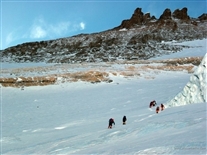
From AAI: "The fixed line currently ends at the base of the Yellow Band- the famous band of rock to be crossed en route from CIII to CIV. Tomorrow many teams, including ours, will be sending Sherpa up to fix the route above starting on Thursday. If there is good weather the route may be fixed all the way to CIV by the end of the day Thursday. Some teams are in position to make a preliminary summit attempt after a week or so."
It would be a plesant surprise if any team made a summit before May 15. The average time over the past decade has been around May 20 and apparently it has snowed quite a bit in the Western CWM (and in BC according to the Doc) and you can assume it is worse higher up. As the following report shows, teams will await the ropes leading to C4 or the South Col before spending precious energy to make the climb. Once a team has spent a night at C3, they are generally in a wait and see mode for a window of 5 days of good weather for the summit attempt. While only late April, there is a lot of activity ahead.
Ed Viesturs' team is back in BC for the next five days. They are taking their time this climb while filming for the future movie. Once ropes are set from C3 to the South Col, they will start the tough climbing (as if C2 to C3 is not!). The Adventure Consultants team report "We saw quite a few teams come down from C2 today with stories of deep snow, and hard going above.".
The Lhotse Face is an interesting climb in that snow is welcome to eliminate the concrete hard ice under your crampons, yet it increases the avalanche danger. With the weather forecasts improving (low winds theough May 1), sometimes teams push their schedule and thus increase the pressure (mostly self induced) on climbers not acclimatizing as fast as others.
One of the most interesting behind the scenes events happened today with Dave Breshears calling a meeting of ten expedition leaders to coordinate which team fixes ropes on the mountains. The spirit of cooperation is high above the ice fall (where Sherpas fix ropes and ladders for a fee under the Minestery of Tourism). But higher on the mountain it is up to the expeditions. This can be an easy task or an impossible one depending on personalities involved and how tight their budget is. 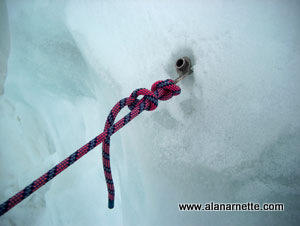
Fixing ropes involves taking thin nylon ropes and attaching it to ice anchors thus providing a safety line to climbers. There is usually old rope already in place in some spots but you cannot count on it since the sun's tradition rots the line and makes it weak an unsafe. Thus new rope is required every year. This is where the Sherpas shine. Free climbing, pounding ice screws, burying anchors and fixing rope higher and higher.
April 27
Kevin Donovan of Expedition Everest.Com reports that he is still not feeling well. He has tightness in his chest and is on antibiotics. He is making a very smart move in staying at BC for 3 to 4 more days. It takes time to let the medicine work but climbers feel immense pressure to keep going. Kevin is showing great maturity by take a few days off.
Sad news from the North Side: David Tait has decided to return home after not acclimatizing. He must be extremely disappointed but probably made the right decision in order to prevent putting himself or his teammates in danger. He said he was experiencing headaches around 5200 meters (17,500'). But to quote David: "Despite bitter personal disappointment, I have to focus on the positives - nearly 200k raised so far for the NSPCC, and a new school for 56 children provided for in Tibet." Well done, mate, well done!
Meanwhile, the Mexico/Canada expedition, continues to push it. A couple of members stayed at C3 for an extra night in order to acclimatize but a storm developed creating some excitement. Most climbers stay at C3 for two nights: one to acclimatize and another on their way to the summit. In 2002, a British climber died after a stormy night at C3. Extra nights are always a dangerous gamble but this team seems to be pushing the limits. I hope they know when they reach them. This is one of the most experienced teams on the mountains AND they are climbing without supplemental Oxygen. Their webmaster contacted me to point out that they needed to test themselves at C3 without O's to be ready for the summit attempt. Climb on guys!!
April 23-25 (updated April 24)
It appears the winds will be mild through the end of the month. But just like anywhere that can change without notice! With Everest sitting so high, it creates it's own weather in addition to being effected by monsoons in India, low pressure over Bhutan. Most expeditions will continue to climb higher.
On the South side, C3 has been established by the Mexican-Canadian expedition. The Viesturs/Gustafsson teams also there. C3 is a tough place where you spend one night to acclimatization and another night as you head for the summit.
It seems that no Sherpas have gone to the South Col, or Camp 4. This is fairly normal since the Sherpas need to pace themselves and they carry oxygen, tents, stove, fuels, food and on and on that the "climber" doesn't . To be clear, without Sherpas, the summit success on Everest would be dramatically lower.
Altitude continues to be a problem for David Tait on the North side. He returned to BC to rest. Kevin Donovan on the South has problems as well. The amount of oxygen in his blood was in the low 60% range. This means he has trouble breathing and feels very weak. The only solution is to go lower, by at least 1,000 feet. The Everest Base Camp Medical Clinic site has an exellent story about a climber coming out the icefall in trouble.
Some of the most consistent dispatches are coming from the commercial expeditions. I have marked the best and most consistent sites with dispatches with a * to **** star rating (4 is best) on the list above. I like the sites that have good pictures, maybe a short video but most importantly, dispatches that talk about how the climbers are feeling: their emotions, their health, the interaction with the other climber - human dynamics. But in any event, take a visit and sign their log books or send them an email. I know from experience that every positive thought helps!
April 20-23 (updated April 22)
The hardest parts of climbing Everest are about to begin. Climbers have been on the mountain for up to three weeks. They are tired, they miss their families but most of all, they want to climb higher - to the summit. It is rare that someone has the experience of climbing to the top five mountains on earth so that they understand the need for patience. It is more common that they have a few of the "seven summits" under their belt and are attempting Everest for the first time ... like I was in 2002!
I am disappointed with the overall dispatches to this point. It is not clear if the teams are having equipment problems, which is common, or that they are simply too pooped to write something and send it. I'll summarize the best dispatches thus far in the next few updates.
In any event, the Viesturs/Gustafsson team has some great dispatches. Ed just posted one about climbing to C3, 24000'. They are not only climbing but also fixing the ropes. This is a tedious process of "free climbing" - without ropes and screwing ice screws (about six inches long) into concrete hard ice. All this on a 45 degree angle! Meanwhile the AAI and AC teams are taking their time, which is smart since the jet stream usually doesn't move off Everest until May 15 through 25 - a lifetime at 8,000 meters!
The Russians continue climbing the hard way experiencing harsh winds, snow and smooth rock. They have found a spot to set up camp at 6200m on the North face!!! David Tait seems to be having a difficult time acclimatizing on the North Side. I am holding out all my hope for him.
The weather looks fantastic through April 27, winds peaking at 15 m.p.h. This should allow most teams to reach C3 for their acclimatization schedule. Usually after a nice spot like this, it turns ugly so expedtions should push themselevs to climb as high as they can.
April 15-20 (updated April 17)
The first emergency evacuation occurred yesterday, a climber from the Irish Expedition on the South Side due to exhaustion and some form of altitude sickness. While somewhat unusual for Everest climbers to have these problems this early in an expedition, it is not rare. Altitude is a strange thing that treats everyone differently. You can do fine one time and crater the next. And it can hit you from 10,000' up. Base camp is around 17,500' so it is quite high. If you rush up the valley from Lukla, sickness is guaranteed. If you take the normal week, it is rare but can still happen. And there is almost nothing you can do to prevent it!
I noticed my old team, Adventure Consultants took an extra day at a village below BC just to make sure everyone was acclimatized - smart move especially since the winds are so bad that no one is going higher than C1 or 2 as I reported in the previous dispatch. It is supposed to calm down this weekend.
On the North, the Russians are calling the North Face "tough", which is quite an admission for the tough Russians. They are doing the absolutely toughest route this year - straight up the North face wall. This means setting protection (cams, ice screws, pitons) into any crack they can find in the rocks. They are truly climbing Mt. Everest.
Finally, David Tait of Himalayan Experience expedition is already making comments about annoying mates on his trip. It does not take long to figure out who you will like and who you will avoid but you still have 6 weeks left on the Hill so you need to figure out how to get along.
April 13-15 (updated April 14)
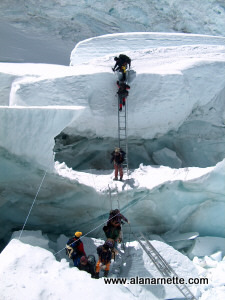 Things are picking up! The Mexican-Canadian Expedition is driving to Camp 3, which has me worried in that they are the first team up there and are literally pushing the Sherpas to fix ropes. While someone has to be first, I wonder if this is the team to do it with a Breashears/Viesturs expedition in camp. Any wonder these professionals are not first? Things are picking up! The Mexican-Canadian Expedition is driving to Camp 3, which has me worried in that they are the first team up there and are literally pushing the Sherpas to fix ropes. While someone has to be first, I wonder if this is the team to do it with a Breashears/Viesturs expedition in camp. Any wonder these professionals are not first?
The overall dispatches from the South and especially the North are few and far between right now since not every team has made it to camps with access to satellites but the few that are in speak of a little colder temps than expected and no problems with Maoist North of Lukla. Now the real action starts for most trips up the ice fall to spend the night at camps 1 and 2.
As reported by Sarah Henley from Mountain Madness "The most exciting ladder in the whole fall is not one ladder, not two ladders, but six ladders tied together at about 80 degrees, which crosses at the top of the ice fall. These are 12 ft. ladders which means this particular system was about 60 ft. long." This is not too unusual in my experience (we had five ladders last year at the top of the ice fall) in that it means the ice fall is a little more difficult than in past years meaning more time in this deadly area.
It snowed fairly well on April 13, not all that unusual. it melts quickly at BC but could be a problem in the ice fall and the Western Cwm. Most expeditions simply take an extra rest day when this happens ... after all there really isn't a great hurry.
Over on the North side, David Tait, is sending some great personal dispatches. This is his third attempt and he has my heart!!
Finally, the weather looks a little dicey. Mt.Everest.net shows winds at 25 to 30 mph at Camp 2 and higher at C3. This is impossible conditions and teams will probably hunker down at C1/C2 or back in BC. The forecast shows lower winds on April 18, Sunday. I would guess that most teams will be content to go up the ice fall, maybe to C1 or 2 and return to BC before spending too much time at the higher camps with the high winds. The issue is that visibility often goes to zero. In the Western Cwm, there are many crevasse and with zero visibility, you cannot see them so it is much safer to sit put.
April 10-13
Most teams are now climbing the ice fall starting their acclimatization schedule. Teams spend a night or two at Camp 1 then another two at Camp 2 after a rest day back at BC. It seems that the Viesturs camp, sponsored by the Discovery channel, is creating quite a stir with their filming for the movie based on the 1996 disaster. These things can be a distraction and hurt inexperienced climbers on Everest. The big names are exciting as is all the filming activity. In 2002, we had the Peter Hillary team doing a film about the 50th annivsery. It is critical to get your rest, eat properly and focus on your climb. However, it is exciting!!
Before starting up the icefall, all expeditions have a puja at base camp. A Lama from a local village treks over. At a eight-foot high stone alter, pictures of the Dali Lama and climbing tools are placed. The Lama chants prayers from centuries old Tibetan prayer books while the climbers, Sherpas and staff sit quietly eating and drinking. (Click on the picture for a video) Occasionally, rice is passed around and thrown into the air three times. Soon fur boughs are lit allowing smoke to rise. The Sherpas hoist a long wooden pole atop the alter that holds five to seven strings of prayer flags that will cover the camp for the duration of the expedition.
This is a very, very special time. You get the sense that this is not your local climb and the Sherpas are unique people. Sometimes, people drink a little too much but the altitude keeps most everyone honest! Rum and coke along with beer seems to be local favorite.
April 1-10
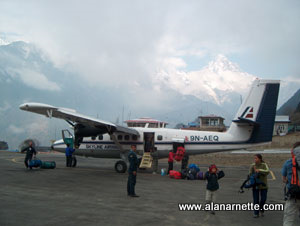 The teams are traveling from Kathmandu this week. There are several big events. Landing in Lukla (click on the picture for a video) is an incredible event. Flying from Kathmadu, you see the barley fields and hill top villages. All of a sudden the airplane starts to drop and you have no idea of where you will land. With a bump, you are in Lukla and the beginning of the trek to base camp. The teams are traveling from Kathmandu this week. There are several big events. Landing in Lukla (click on the picture for a video) is an incredible event. Flying from Kathmadu, you see the barley fields and hill top villages. All of a sudden the airplane starts to drop and you have no idea of where you will land. With a bump, you are in Lukla and the beginning of the trek to base camp.
The Nepalese Ministry of Culture, Tourism and Civil Aviation has issues permits for 11 teams on the South side and word has that this is a low snow year. So the Hill will be less crowded than normal but more rock and ice underfoot. 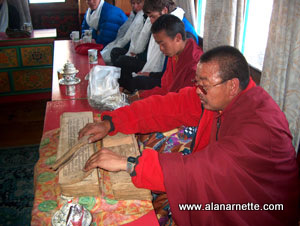
Multiple expeditions are now sending dispatches. Most are describing their trek from Lukla to base camp. It seems that the Maoist have created significant problems in Kathmandu mostly with transportation and some strikes closing restaurant and stores. This is a not a big problem but for expeditions that wanted to pick up some last minute drugs or gear, it is annoying.
One of the great experiences all teams go through is the Puja. This is a ceremony conducted by a local Lama. Usually climbers have at least two Pujas, one trekking in through the Khumbu and another at base camp. The picture on the left is a Lama reading for a 300 year old Tibetean prayer book in Namche. (Click on the picture for the video).
The Mexican-Canadian Expedition has already reached Camp 1 and seems to be leading all the other expeditions. This is interesting in that most years, the winds do not move off the summit until after May 15 so this team may be getting ahead just in time for a two week wait. Ed Viesturs and Veikka Gustafsson are in BC but have not gone up the ice fall.
March, 2004
Many expeditions are now traveling or getting ready to travel to Kathmandu, the most common launch site for climbing to the top of the world. This year's expeditions are the usual variety of commercial, personal and theme climbs. An interesting one is the Everest Peace Project. This is a truly international 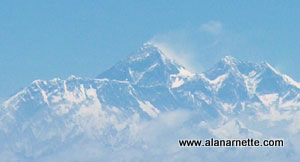 effort consisting of climbers with a wide variety of religious beliefs. Another one that caught my eye was the Russian North Wall - an ambitious effort to summit via very difficult route. effort consisting of climbers with a wide variety of religious beliefs. Another one that caught my eye was the Russian North Wall - an ambitious effort to summit via very difficult route.
It seems that climbing Everest has turned into a three ring circus these days. To receive press coverage, the expedition claims to be the first at something: disabilities, route, hang gliding, skiing, politics, etc. What happened to just climbing for the love of climbing?
Arriving at Kathmandu is sensory overload. Most climbers from the US connect through Bangkok and 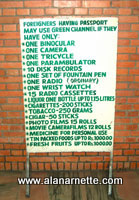 fly Thai Airline flight 319 arriving into Kathmandu around 1:00 in the afternoon. Flying in, if you sat on the right side of the airplane, you can see Everest on a clear day. After landing, you walk down the mobile stairs (KTM is a s m a l l airport) into the customs and luggage area. A sign on the wall tells you what you can and cannot bring into the country. It is hot and very humid and the place feels like an ant farm on a windy day. Some people pass their luggage through the x-ray machine, some do not. If you don't want to, you don't - amazing! fly Thai Airline flight 319 arriving into Kathmandu around 1:00 in the afternoon. Flying in, if you sat on the right side of the airplane, you can see Everest on a clear day. After landing, you walk down the mobile stairs (KTM is a s m a l l airport) into the customs and luggage area. A sign on the wall tells you what you can and cannot bring into the country. It is hot and very humid and the place feels like an ant farm on a windy day. Some people pass their luggage through the x-ray machine, some do not. If you don't want to, you don't - amazing!
Meeting your hosts outside the luggage area, you usually cram into a Yugo size car with some other teammates you don't ka short ride to the hotel. Now is when it hits you that you are not in Kansas anymore! There are cows walking in the street, cows 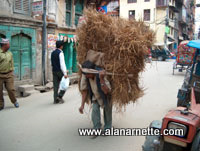 sleeping in the street and people walking barefoot on the hard packed dirt sidewalks, sometimes carrying a corpse for cremation at the Bagmati River. The buildings are mostly mud bricks built by hand on bamboo scaffolding. Yes, you are in a third world country and about to go farther! sleeping in the street and people walking barefoot on the hard packed dirt sidewalks, sometimes carrying a corpse for cremation at the Bagmati River. The buildings are mostly mud bricks built by hand on bamboo scaffolding. Yes, you are in a third world country and about to go farther!
Most climbers stay in the Thamel area which is Western only in the signs. It is usually bustling with activity - people wanting to fix your shoes, sell you smokes, or anything else you want, and a plethora of stores with climbing gear, rugs, medicines and many restaurants. I always made a visit to Fire & Ice Pizza - run by an Italian couple they make a great pizza marguerita! That along with a pint of beer, I read the Herald Tribune as I think about what was ahead for the next two months. Unfortunatley, this year, it seems that the maoust rebels are still creating problems with a strike called in Kathmandu that has closed all the shops and resturants. This is a common tatic that disrupts commerce but usually is not threating to climbers. For the past several years, a truce has been called around Arpil 1st, just in time for most expeditions to safely make their way throught the Khumbu. Well see what happens this year.
At the hotel, you meet the rest of your expedition - the people you will spend the next two months - talking, eating, sleeping with almost 24 hours a day. You begin to sort out who will be fun and who will be a pain. But most of all, who you can count on as a climbing partner.
The early reports from Nepal and an expedition on Pumori, which is right next to Everest Base Camp (EBC) is that there is less snow than usual this year. This means the route high up on Everest will be more rock and more difficult especally if covered with ice.
February, 2004
For the climbers, this is the time for pushing your training to the limits. They are training with full packs, pushing heart rates to maximum and running long courses to build endurance along with strength. Getting the gear finalized continues to be a task especially if some have to be ordered.
For the expedition organizers, its all about the details. Some expeditions have actually sent some Sherpas to base camp on the south side. There they stake out their camps with rocks and signs. It is first come, first served at BC. While you must have a permit from the Ministry of Tourism to establish a site at BC, there is no organized approach to who gets which site. Some prefer being as close to the foot of the Khumbu Icefall to minimize the walk to camp while others prefer to be far away to minimize the traffic. In either approach, there is a huge task of preparing the site.
It appears that this season will be busy as ever with slightly more North side expeditions. This is probably due to the lower fees charged by China than on the South side by Nepal. The fees in US dollars for a South Side permit are: $25,000-1 climber, $40,000-2, $48,000-3, $56,000-4, $60,000-5, $66,000-6, $70,000-7 and $10,000 for each additional climber up to 10 on one permit. Also there is a fee for bringing a sat phone into Nepal of $2,500. Finally, another $2500 per expedition for fixing rope in the Khumbu icefall.
Another trend is the "a la cart" approach to pricing. Some expeditions are advertising prices as low as $6,000 but this does not include food above advanced base camp, Sherpas, guides, oxygen and on and on. They charge $300 per oxygen bottle, $4,000 per climbing Sherpa. A popular option to reduce expenses are "base camp services" which is a good deal if you have the experience. You get logistics support, a spot on a permit with other climbers but no formal guiding.
January, 2004 - The Preparation
Training is the key activity for all Everest climbers. With only three months before arriving in Kathmandu or Lhasa, climbers should be extremely fit. They have been working on their cardio by running, strength by lifting weights and getting some real world miles under their feet hopefully by climbing. Many people underestimate how climbing Everest is a total physical experience. You need to have balance throughout your training regime But there is also the psychology of climbing. You can train your mind just like your body with visualization techniques as well as pushing even harder when you think you cannot go on during training. I chronicled my training both years, if you are interested.
Another major activity at this point is rounding up the final gear. Some climbers have been known to arrive on Everest with brand new boots - never used and straight out of the box. Once on the Hill, there is no REI nearby! Hopefully most of the gear has been used and the climbers are comfortable with it. They know how to use crampons, ice axes, harness, carabiners and all the other gear. My personal gear list was honed after many climbs and served me well. |
Quick Links
Everest Home
Alan's Everest Climbs
2002 Climb
2003 Climb
2008 Climb
Alan's Everest Coverage
Everest 2004
Everest 2005
Everest 2006
Everest 2007
Route Maps
South Col
North Ridge
Picture Galleries
Trek to BC
Base Camp
Khumbu Icefall
Western Cwm
Lhotse Face
South Col and Summit Bid
Resources
Climbing Gear
Compare Everest
Everest for Kids
Background Articles
Training
Clothes
Oxygen
Weather |

